1,4-Disubstituted-1,2,3-Triazole Compounds Induce Ultrastructural Alterations in Leishmania amazonensis Promastigote: An in Vitro Antileishmanial and in Silico Pharmacokinetic Study
Abstract
1. Introduction
2. Results
2.1. Activity of 1,4-Disubstituted-1,2,3-Triazole against L. amazonensis Promastigote and Intracellular Amastigote Forms
2.2. Cytotoxicity and Selectivity Index (SI) of 1,4-Disubstituted-1,2,3-Triazole Compounds
2.3. Ultrastructural Alterations in L. amazonensis Promastigotes Treated with 1,4-Disubstituted-1,2,3-Triazole Compounds
2.4. Nitrite Quantification in Supernatant of Peritoneal Macrophages Treated with 1,4-Disubstituted-1,2,3-Triazole Compounds
2.5. In Silico Drug-Likeness Prediction
2.6. In Silico Pharmacokinetics and Toxicity Prediction
3. Discussion
4. Materials and Methods
4.1. Reagents
4.2. Triazole Compounds
4.3. Parasites
4.4. Activity against Promastigote Forms
4.5. Animals
4.6. Cell Culture
4.7. Cytotoxicity Assay
4.8. Activity against Intracellular Amastigote and Selectivity Index
4.9. Transmission Electron Microscopy
4.10. Nitrite Quantification in Macrophages Stimulated with L. amazonensis and Treated with Triazoles
4.11. In Silico Pharmacokinetics Prediction
4.12. Statistical Analyses
5. Conclusions
Author Contributions
Funding
Conflicts of Interest
Abbreviations
| WHO | World Health Organization |
| IC50 | inhibitory concentration of 50% |
| CC50 | cytotoxicity concentration of 50% |
| SI | selectivity index |
| TPSA | topological polar surface area |
| PAINS | pan-assay interference compounds |
| VDss | steady state volume of distribution |
| CNS | central nervous system |
| BBB | blood-brain barrier |
| hERG | human ether-a-go-go gene |
| AMES | Salmonella/microsome mutagenicity assay |
| LOAEL | lowest dose of a compound that results in an observed adverse effect |
| OCT2 | organic cation transporter 2, |
| DMSO | dimethyl sulfoxide |
| MTT | 3-(4,5-dimethylthiazol-2-yl)-2,5-diphenyltetrazolium bromide |
References
- Murray, H.W.; Berman, J.D.; Davies, C.R.; Saravia, N.G. Advances in leishmaniasis. Lancet 2005, 366, 1561–1577. [Google Scholar] [CrossRef]
- Yeshaw, Y.; Tsegaye, A.T.; Nigatu, S.G. Incidence of Mortality and Its Predictors Among Adult Visceral Leishmaniasis Patients at the University of Gondar Hospital: A Retrospective Cohort Study. Infect. Drug Resist. 2020, 13. [Google Scholar] [CrossRef] [PubMed]
- Alvar, J.; Vélez, I.D.; Bern, C.; Herrero, M.; Desjeux, P.; Cano, J.; Jannin, J.; den Boer, M.; Team, W.L.C. Leishmaniasis worldwide and global estimates of its incidence. PLoS ONE 2012, 7, e35671. [Google Scholar] [CrossRef] [PubMed]
- WHO. WHO Epidemiological Situation. Available online: https://www.who.int/leishmaniasis/burden/en/ (accessed on 5 June 2020).
- Lanza, J.S.; Pomel, S.; Loiseau, P.M.; Frézard, F. Recent Advances in Amphotericin B Delivery Strategies for the Treatment of Leishmaniases. Expert Opin. Drug Deliv. 2019, 16. [Google Scholar] [CrossRef] [PubMed]
- Uliana, S.R.; Trinconi, C.T.; Coelho, A.C. Chemotherapy of leishmaniasis: Present challenges. Parasitology 2017, 1–17. [Google Scholar] [CrossRef] [PubMed]
- Khatri, A.; Sah, R.; Timalsena, S.; Kharel, M. Miltefosine-related Paracentral Ulcerative Keratolysis in a Patient with Active Cutaneous Leishmaniasis From Nepal. Trop. Dr. 2020. [Google Scholar] [CrossRef]
- Oliveira, L.F.; Schubach, A.O.; Martins, M.M.; Passos, S.L.; Oliveira, R.V.; Marzochi, M.C.; Andrade, C.A. Systematic Review of the Adverse Effects of Cutaneous Leishmaniasis Treatment in the New World. Acta Trop. 2011, 118. [Google Scholar] [CrossRef]
- Aronson, N.E. Addressing a clinical challenge: Guidelines for the diagnosis and treatment of leishmaniasis. BMC Med. 2017, 15, 76. [Google Scholar] [CrossRef]
- Corrêa Soares, G.H.; Santos da Silva, A.B.; Salomão de Sousa Ferreira, L.; Ithamar, J.S.; de Alencar Medeiros, G.; Ferreira Pereira, S.R.; Sousa Lima, M.I.; de Maria Pedrozo E Silva de Azevedo, C. Case Report: Coinfection by Leishmania amazonensis and HIV in a Brazilian Diffuse Cutaneous Leishmaniasis Patient. Am. J. Trop. Med. Hyg. 2020. [Google Scholar] [CrossRef]
- Dheer, D.; Singh, V.; Shankar, R. Medicinal Attributes of 1,2,3-triazoles: Current Developments. Bioorg. Chem. 2017, 71. [Google Scholar] [CrossRef]
- Kolb, H.C.; Sharpless, K.B. The Growing Impact of Click Chemistry on Drug Discovery. Drug Discov. Today 2003, 8. [Google Scholar] [CrossRef]
- Bonandi, E.; Christodoulou, M.S.; Fumagalli, G.; Perdicchia, D.; Rastelli, G.; Passarella, D. The 1,2,3-triazole Ring as a Bioisostere in Medicinal Chemistry. Drug Discov. Today 2017, 22. [Google Scholar] [CrossRef] [PubMed]
- Boechat, N.; Ferreira, V.F.; Ferreira, S.B.; de Lourdes G Ferreira, M.; de C da Silva, F.; Bastos, M.M.; Dos S Costa, M.; Lourenço, M.C.; Pinto, A.C.; Krettli, A.U.; et al. Novel 1,2,3-triazole Derivatives for Use Against Mycobacterium Tuberculosis H37Rv (ATCC 27294) Strain. J. Med. Chem. 2011, 54. [Google Scholar] [CrossRef]
- Mady, M.F.; Awad, G.E.; Jørgensen, K.B. Ultrasound-assisted Synthesis of Novel 1,2,3-triazoles Coupled Diaryl Sulfone Moieties by the CuAAC Reaction, and Biological Evaluation of Them as Antioxidant and Antimicrobial Agents. Eur. J. Med. Chem. 2014, 84. [Google Scholar] [CrossRef] [PubMed]
- Song, M.X.; Deng, X.Q. Recent Developments on Triazole Nucleus in Anticonvulsant Compounds: A Review. J. Enzym. Inhib. Med. Chem. 2018, 33. [Google Scholar] [CrossRef]
- Mohammed, I.; Kummetha, I.R.; Singh, G.; Sharova, N.; Lichinchi, G.; Dang, J.; Stevenson, M.; Rana, T.M. 1,2,3-Triazoles as Amide Bioisosteres: Discovery of a New Class of Potent HIV-1 Vif Antagonists. J. Med. Chem. 2016, 59. [Google Scholar] [CrossRef]
- Yadav, P.; Lal, K.; Kumar, A.; Guru, S.K.; Jaglan, S.; Bhushan, S. Green Synthesis and Anticancer Potential of Chalcone linked-1,2,3-triazoles. Eur. J. Med. Chem. 2017, 126. [Google Scholar] [CrossRef]
- Tornøe, C.W.; Christensen, C.; Meldal, M. Peptidotriazoles on Solid Phase: [1,2,3]-triazoles by Regiospecific Copper(i)-Catalyzed 1,3-dipolar Cycloadditions of Terminal Alkynes to Azides. J. Org. Chem. 2002, 67. [Google Scholar] [CrossRef] [PubMed]
- Kolb, H.C.; Finn, M.G.; Sharpless, K.B. Click Chemistry: Diverse Chemical Function From a Few Good Reactions. Angew. Chem. 2001, 40. [Google Scholar] [CrossRef]
- Chen, Y.; Yao, K.; Wang, K.; Xiao, C.; Li, K.; Khan, B.; Zhao, S.; Yan, W.; Ye, Y. Bioactive-guided Structural Optimization of 1,2,3-triazole Phenylhydrazones as Potential Fungicides Against Fusarium Graminearum. Pestic. Biochem. Physiol. 2020, 164. [Google Scholar] [CrossRef]
- Meinel, R.S.; Almeida, A.D.C.; Stroppa, P.H.F.; Glanzmann, N.; Coimbra, E.S.; da Silva, A.D. Novel Functionalized 1,2,3-triazole Derivatives Exhibit Antileishmanial Activity, Increase in Total and mitochondrial-ROS and Depolarization of Mitochondrial Membrane Potential of Leishmania amazonensis. Chem. Biol. Interact. 2020, 315. [Google Scholar] [CrossRef]
- Stroppa, P.H.F.; Antinarelli, L.M.R.; Carmo, A.M.L.; Gameiro, J.; Coimbra, E.S.; da Silva, A.D. Effect of 1,2,3-triazole Salts, Non-Classical Bioisosteres of Miltefosine, on Leishmania amazonensis. Bioorgan. Med. Chem. 2017, 25. [Google Scholar] [CrossRef] [PubMed]
- Da Silva, V.D.; de Faria, B.M.; Colombo, E.; Ascari, L.; Freitas, G.P.A.; Flores, L.S.; Cordeiro, Y.; Romão, L.; Buarque, C.D. Design, Synthesis, Structural Characterization and in Vitro Evaluation of New 1,4-disubstituted-1,2,3-triazole Derivatives Against Glioblastoma Cells. Bioorgan. Chem. 2019, 83. [Google Scholar] [CrossRef]
- Queen, A.; Khan, P.; Idrees, D.; Azam, A.; Hassan, M.I. Biological Evaluation of P-Toluene Sulphonylhydrazone as Carbonic Anhydrase IX Inhibitors: An Approach to Fight Hypoxia-Induced Tumors. Int. J. Biol. Macromol. 2018, 106. [Google Scholar] [CrossRef] [PubMed]
- Sangshetti, J.N.; Kalam Khan, F.A.; Kulkarni, A.A.; Aroteb, R.; Patilc, R.H. Antileishmanial drug discovery: Comprehensive review of the last 10 years. RSC Adv. 2015, 32376–32415. [Google Scholar] [CrossRef]
- Maji, K.; Abbasi, M.; Podder, D.; Datta, R.; Haldar, D. Potential Antileishmanial Activity of a Triazole-Based Hybrid Peptide against Leishmania major. ChemistrySelect 2018, 3, 10220–10225. [Google Scholar] [CrossRef]
- Rodrigues, M.P.; Tomaz, D.C.; Ângelo de Souza, L.; Onofre, T.S.; Aquiles de Menezes, W.; Almeida-Silva, J.; Suarez-Fontes, A.M.; Rogéria de Almeida, M.; Manoel da Silva, A.; Bressan, G.C. Synthesis of Cinnamic Acid Derivatives and Leishmanicidal Activity Against Leishmania Braziliensis. Eur. J. Med. Chem. 2019, 183. [Google Scholar] [CrossRef] [PubMed]
- Temraz, M.G.; Elzahhar, P.A.; El-Din A Bekhit, A.; Bekhit, A.A.; Labib, H.F.; Belal, A.S.F. Anti-leishmanial Click Modifiable Thiosemicarbazones: Design, Synthesis, Biological Evaluation and in Silico Studies. Eur. J. Med. Chem. 2018, 151. [Google Scholar] [CrossRef]
- Zhao, C.; Rakesh, K.P.; Ravidar, L.; Fang, W.Y.; Qin, H.L. Pharmaceutical and Medicinal Significance of Sulfur (S VI)-Containing Motifs for Drug Discovery: A Critical Review. Eur. J. Med. Chem. 2019, 162. [Google Scholar] [CrossRef]
- Coimbra, E.S.; Antinarelli, L.M.R.; de A Crispi, M.; Nogueira, T.C.M.; Pinheiro, A.C.; de Souza, M.V.N. Synthesis, Biological Activity, and Mechanism of Action of 2-Pyrazyl and Pyridylhydrazone Derivatives, New Classes of Antileishmanial Agents. ChemMedChem 2018, 13. [Google Scholar] [CrossRef]
- da Silva, E.T.; de Andrade, G.F.; Araújo, A.D.S.; Almeida, A.D.C.; Coimbra, E.S.; de Souza, M.V.N. In Vitro Assessment of Camphor Hydrazone Derivatives as an Agent Against Leishmania amazonensis. Acta Parasitol. 2020, 65. [Google Scholar] [CrossRef] [PubMed]
- Enoch, S.J.; Ellison, C.M.; Schultz, T.W.; Cronin, M.T. A Review of the Electrophilic Reaction Chemistry Involved in Covalent Protein Binding Relevant to Toxicity. Crit. Rev. Toxicol. 2011, 41. [Google Scholar] [CrossRef] [PubMed]
- Oliveira, R.G.; Guerra, F.S.; Mermelstein, C.D.S.; Fernandes, P.D.; Bastos, I.T.S.; Costa, F.N.; Barroso, R.C.R.; Ferreira, F.F.; Fraga, C.A.M. Synthesis and Pharmacological Evaluation of Novel Isoquinoline N-sulphonylhydrazones Designed as ROCK Inhibitors. J. Enzym. Inhib. Med. Chem. 2018, 33. [Google Scholar] [CrossRef] [PubMed]
- Vargas, E.; Echeverri, F.; Upegui, Y.A.; Robledo, S.M.; Quiñones, W. Hydrazone Derivatives Enhance Antileishmanial Activity of Thiochroman-4-ones. Molecules 2017, 23, 70. [Google Scholar] [CrossRef] [PubMed]
- Katsuno, K.; Burrows, J.N.; Duncan, K.; Hooft van Huijsduijnen, R.; Kaneko, T.; Kita, K.; Mowbray, C.E.; Schmatz, D.; Warner, P.; Slingsby, B.T. Hit and lead criteria in drug discovery for infectious diseases of the developing world. Nat. Rev. Drug Discov. 2015, 14, 751–758. [Google Scholar] [CrossRef]
- Cardozo Pinto de Arruda, C.; de Jesus Hardoim, D.; Silva Rizk, Y.; da Silva Freitas de Souza, C.; Zaverucha do Valle, T.; Bento Carvalho, D.; Nosomi Taniwaki, N.; de Morais Baroni, A.C.; da Silva Calabrese, K. A Triazole Hybrid of Neolignans as a Potential Antileishmanial Agent by Triggering Mitochondrial Dysfunction. Molecules 2019, 25, 37. [Google Scholar] [CrossRef]
- Teixeira de Macedo Silva, S.; Visbal, G.; Lima Prado Godinho, J.; Urbina, J.A.; de Souza, W.; Cola Fernandes Rodrigues, J. In Vitro Antileishmanial Activity of Ravuconazole, a Triazole Antifungal Drug, as a Potential Treatment for Leishmaniasis. J. Antimicrob. Chemother. 2018, 73. [Google Scholar] [CrossRef]
- Almeida-Souza, F.; Taniwaki, N.N.; Amaral, A.C.; da Silva Freitas de Souza, C.; da Silva Calabrese, K.; Abreu-Silva, A.L. Ultrastructural Changes and Death of Leishmania infantum Promastigotes Induced by Morinda citrifolia Linn. Fruit (Noni) Juice Treatment. Evid. Based Complement. Alternat. Med. 2016, 2016, 5063540. [Google Scholar] [CrossRef]
- Rodrigues, J.C.; Attias, M.; Rodriguez, C.; Urbina, J.A.; Souza, W. Ultrastructural and biochemical alterations induced by 22,26-azasterol, a delta(24(25))-sterol methyltransferase inhibitor, on promastigote and amastigote forms of Leishmania amazonensis. Antimicrob. Agents Chemother. 2002, 46, 487–499. [Google Scholar] [CrossRef]
- Roberts, C.W.; McLeod, R.; Rice, D.W.; Ginger, M.; Chance, M.L.; Goad, L.J. Fatty Acid and Sterol Metabolism: Potential Antimicrobial Targets in Apicomplexan and Trypanosomatid Parasitic Protozoa. Mol. Biochem. Parasitol. 2003, 126. [Google Scholar] [CrossRef]
- Bredt, D.S. Endogenous Nitric Oxide Synthesis: Biological Functions and Pathophysiology. Free Radic. Res. 1999, 31. [Google Scholar] [CrossRef] [PubMed]
- Almeida-Souza, F.; da Silva Freitas de Souza, C.; Taniwaki, N.N.; Silva, J.J.; de Oliveira, R.M.; Abreu-Silva, A.L.; Calabrese, K. Morinda citrifolia Linn. fruit (Noni) juice induces an increase in NO production and death of Leishmania amazonensis amastigotes in peritoneal macrophages from BALB/c. Nitric Oxide 2016, 58, 51–58. [Google Scholar] [CrossRef]
- Bogdan, C. Nitric Oxide Synthase in Innate and Adaptive Immunity: An Update. Trends Immunol. 2015, 36. [Google Scholar] [CrossRef] [PubMed]
- Daina, A.; Michielin, O.; Zoete, V. SwissADME: A Free Web Tool to Evaluate Pharmacokinetics, Drug-Likeness and Medicinal Chemistry Friendliness of Small Molecules. Sci. Rep. 2017, 7. [Google Scholar] [CrossRef] [PubMed]
- Lipinski, C.A.; Lombardo, F.; Dominy, B.W.; Feeney, P.J. Experimental and Computational Approaches to Estimate Solubility and Permeability in Drug Discovery and Development Settings. Adv. Drug Deliv. Rev. 2001, 46. [Google Scholar] [CrossRef]
- Pires, D.E.; Blundell, T.L.; Ascher, D.B. pkCSM: Predicting Small-Molecule Pharmacokinetic and Toxicity Properties Using Graph-Based Signatures. J. Med. Chem. 2015, 58. [Google Scholar] [CrossRef] [PubMed]
- Mosmann, T. Rapid colorimetric assay for cellular growth and survival: Application to proliferation and cytotoxicity assays. J. Immunol. Methods 1983, 65, 55–63. [Google Scholar] [CrossRef]
- Teles, A.M.; Rosa, T.; Mouchrek, A.N.; Abreu-Silva, A.L.; Calabrese, K.D.S.; Almeida-Souza, F. Cinnamomum zeylanicum, Origanum vulgare, and Curcuma longa Essential Oils: Chemical Composition, Antimicrobial and Antileishmanial Activity. Evid. Based Complement. Alternat. Med. 2019, 2019, 2421695. [Google Scholar] [CrossRef]
- Almeida-Souza, F.; de Oliveira, A.E.R.; Abreu-Silva, A.L.; da Silva Calabrese, K. In vitro activity of Morinda citrifolia Linn. fruit juice against the axenic amastigote form of Leishmania amazonensis and its hydrogen peroxide induction capacity in BALB/c peritoneal macrophages. BMC Res. Notes 2018, 11, 492. [Google Scholar] [CrossRef]
- Oliveira, I.S.S.; Colares, A.V.; Cardoso, F.O.; Tellis, C.J.M.; Chagas, M.S.S.; Behrens, M.D.; Calabrese, K.S.; Almeida-Souza, F.; Abreu-Silva, A.L. Vernonia Polysphaera Baker: Anti-inflammatory Activity in Vivo and Inhibitory Effect in LPS-stimulated RAW 264.7 Cells. PLoS ONE 2019, 14. [Google Scholar] [CrossRef]
- Oliveira, I.; Moragas Tellis, C.J.; Chagas, M.; Behrens, M.D.; Calabrese, K.D.S.; Abreu-Silva, A.L.; Almeida-Souza, F. Carapa guianensis Aublet (Andiroba) Seed Oil: Chemical Composition and Antileishmanial Activity of Limonoid-Rich Fractions. Biomed. Res. Int 2018, 2018, 5032816. [Google Scholar] [CrossRef] [PubMed]
- Da Silva, V.D.; Almeida-Souza, F.; Teles, A.M.; Neto, P.A.; Mondego-Oliveira, R.; Mendes Filho, N.E.; Taniwaki, N.N.; Abreu-Silva, A.L.; Calabrese, K.d.S.; Mouchrek Filho, V.E. Chemical composition of Ocimum canum Sims. essential oil and the antimicrobial, antiprotozoal and ultrastructural alterations it induces in Leishmania amazonensis promastigotes. Ind. Crops Prod. 2018, 119, 201–208. [Google Scholar] [CrossRef]
- Green, L.C.; Wagner, D.A.; Glogowski, J.; Skipper, P.L.; Wishnok, J.S.; Tannenbaum, S.R. Analysis of nitrate, nitrite, and [15N]nitrate in biological fluids. Anal. Biochem. 1982, 126, 131–138. [Google Scholar] [CrossRef]

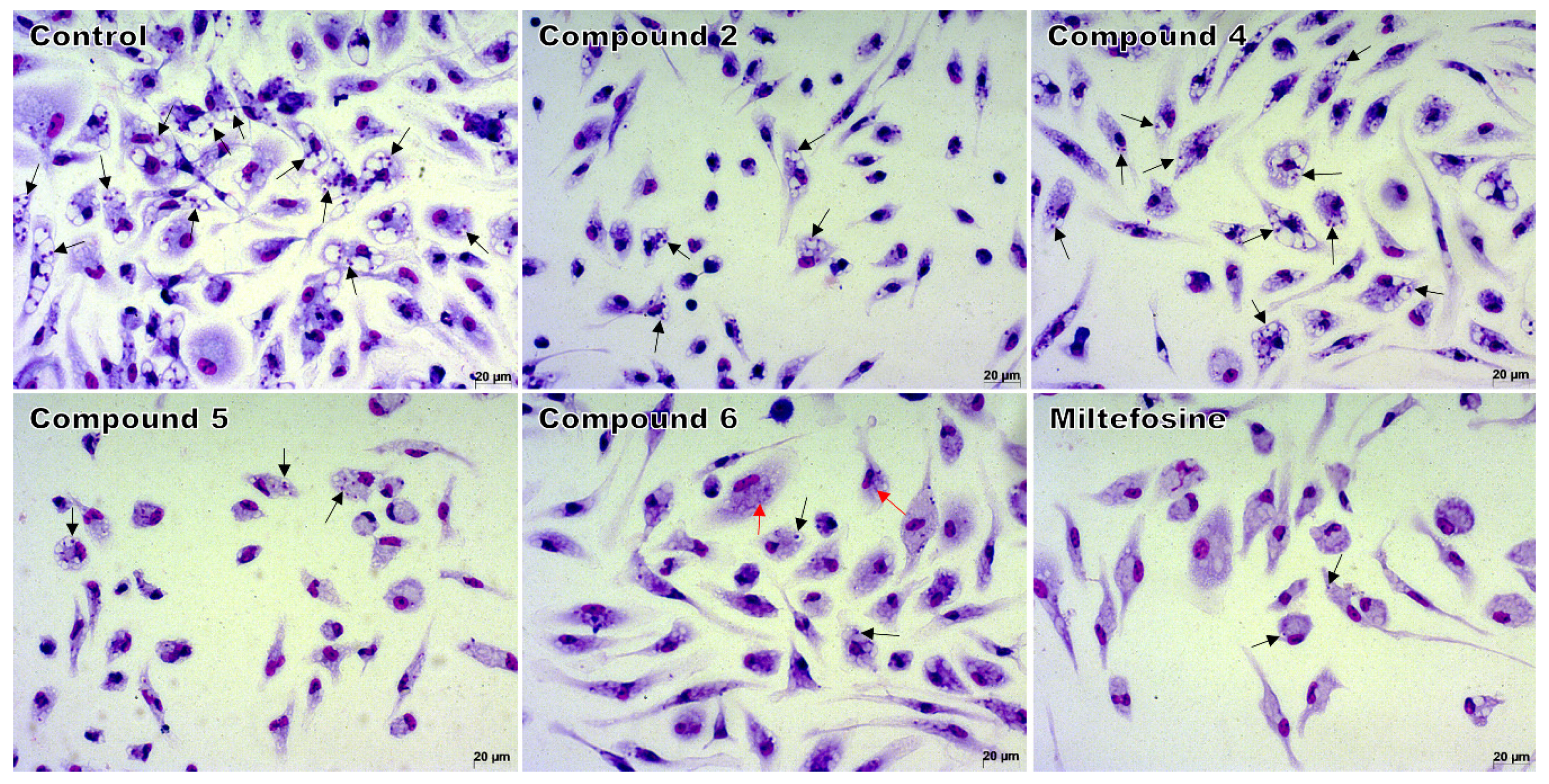
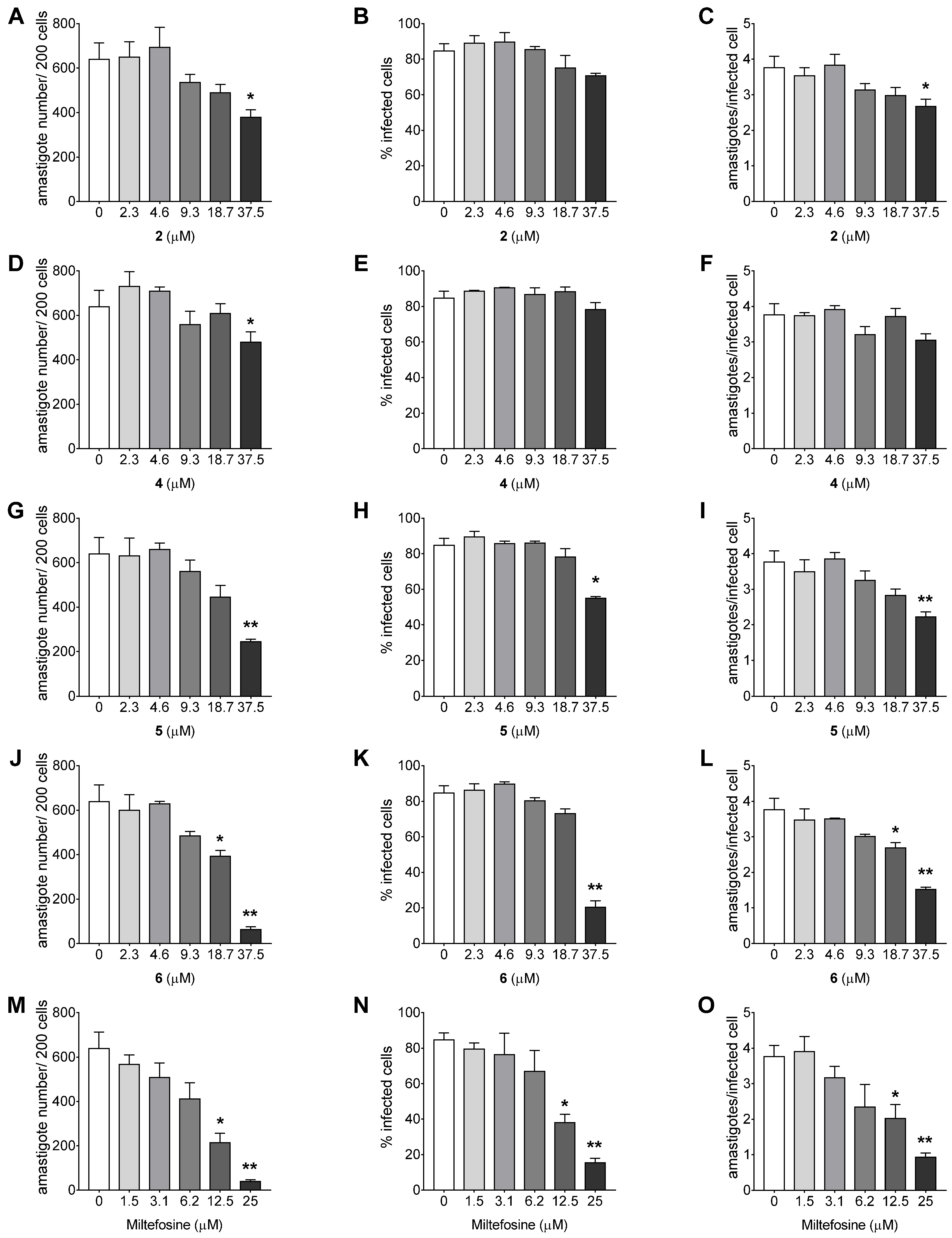
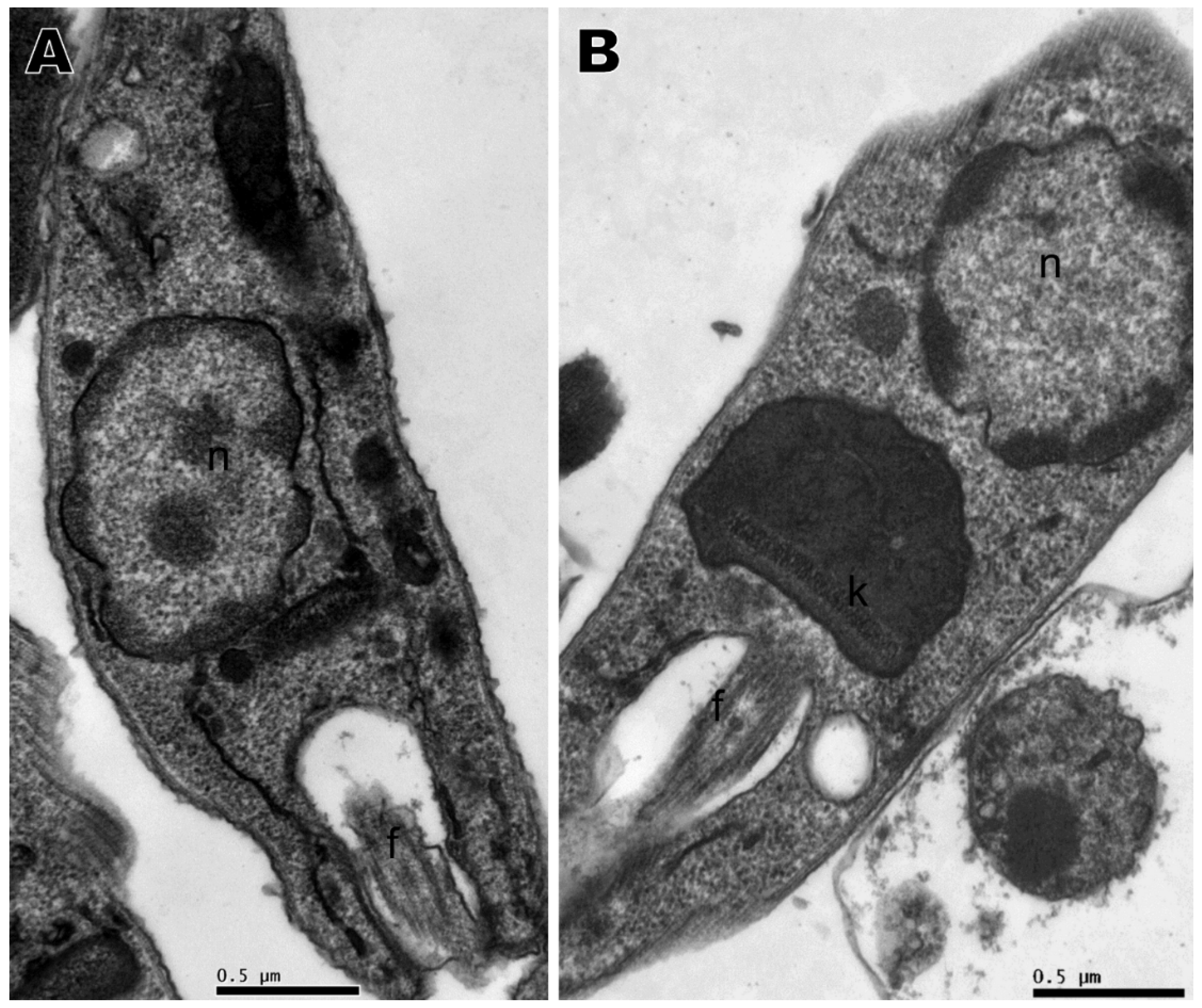
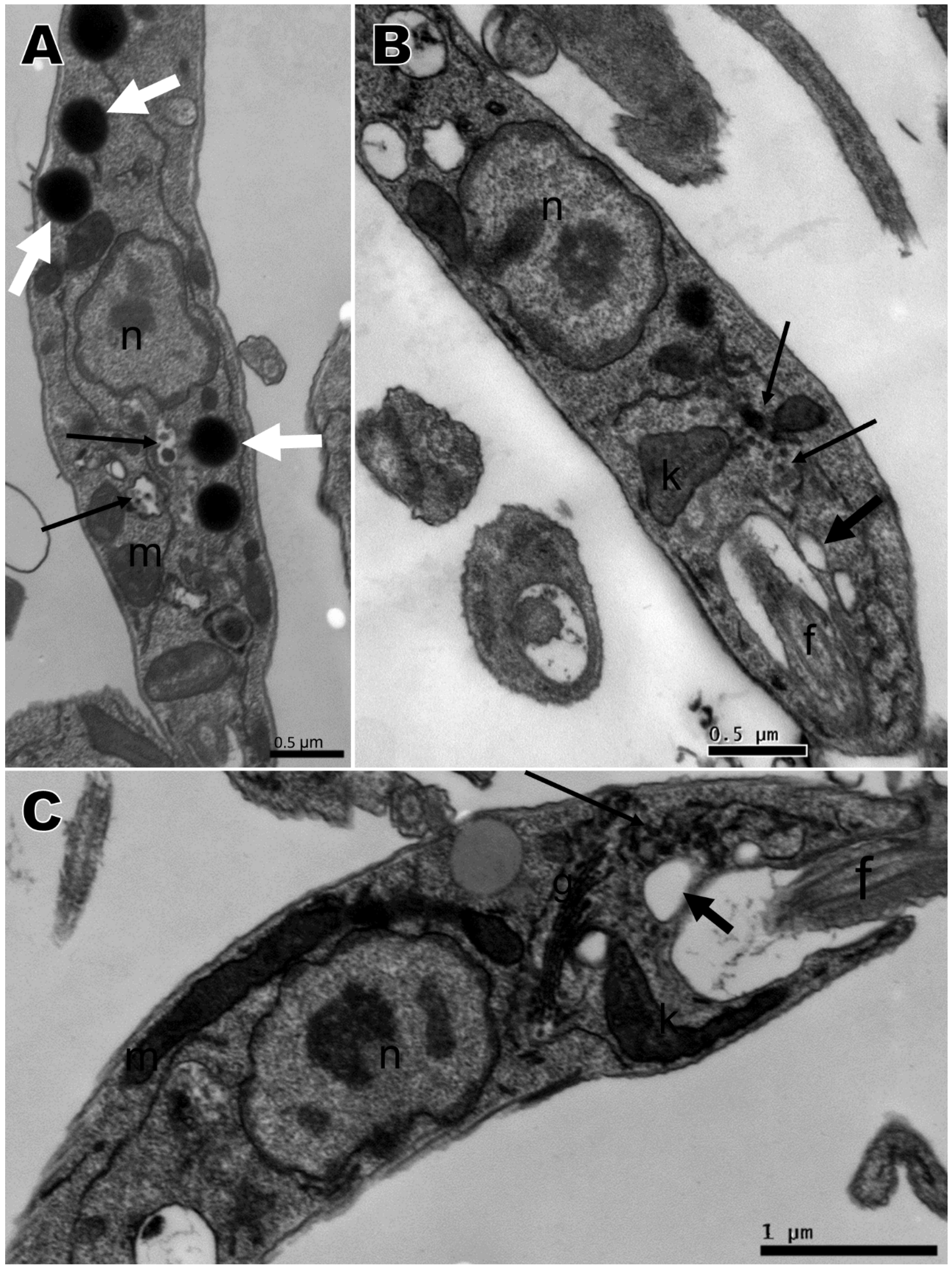
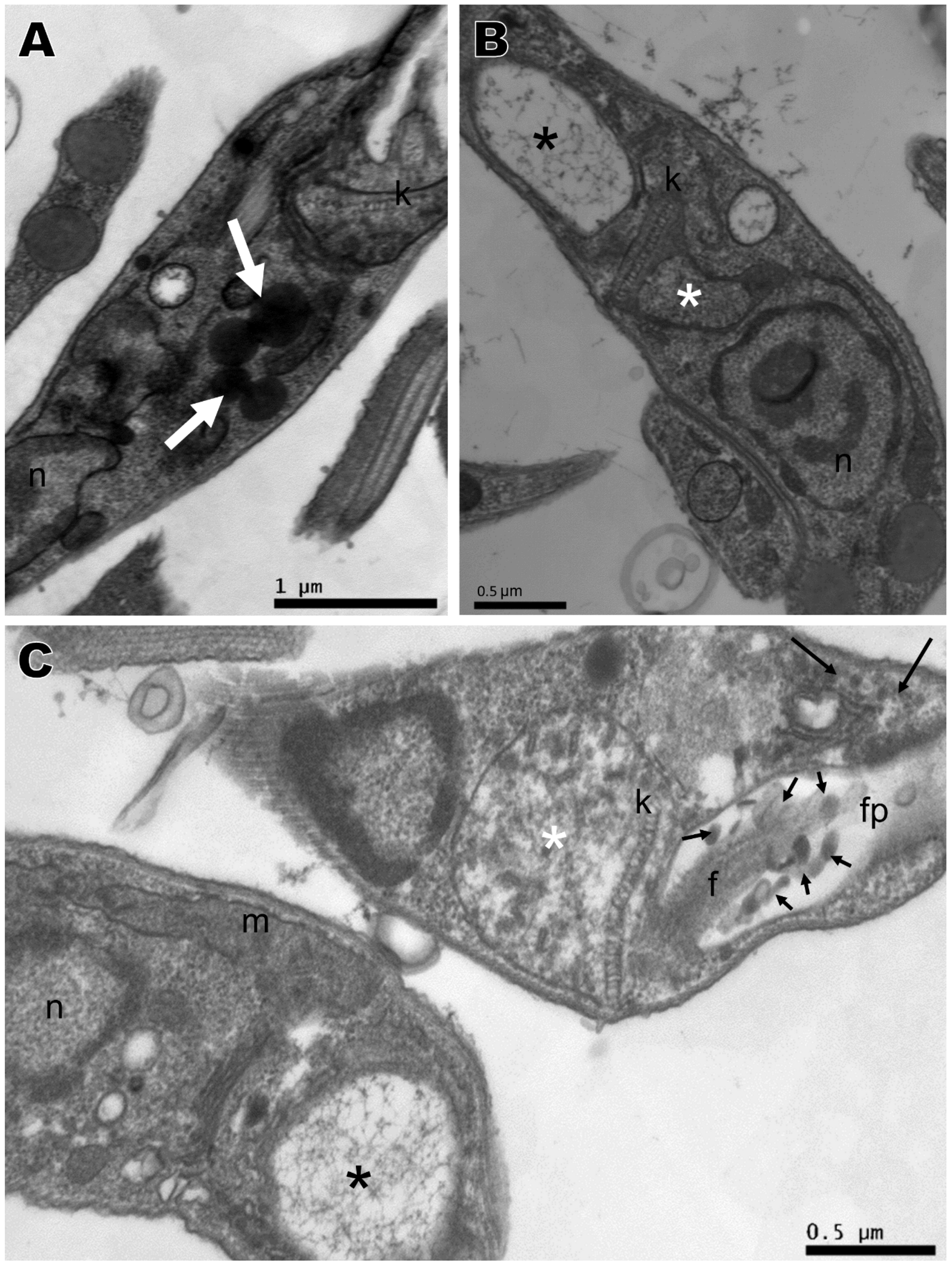
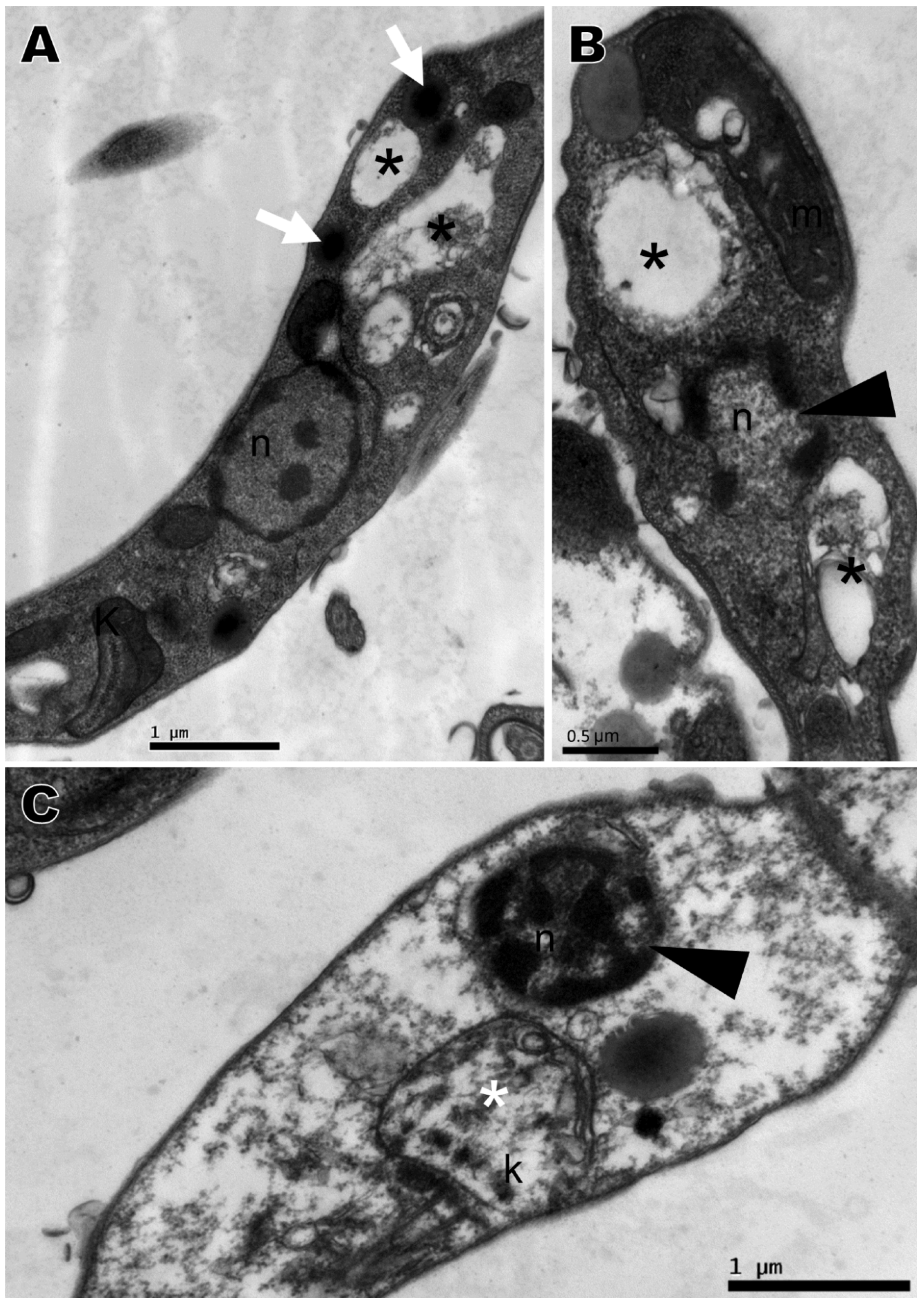
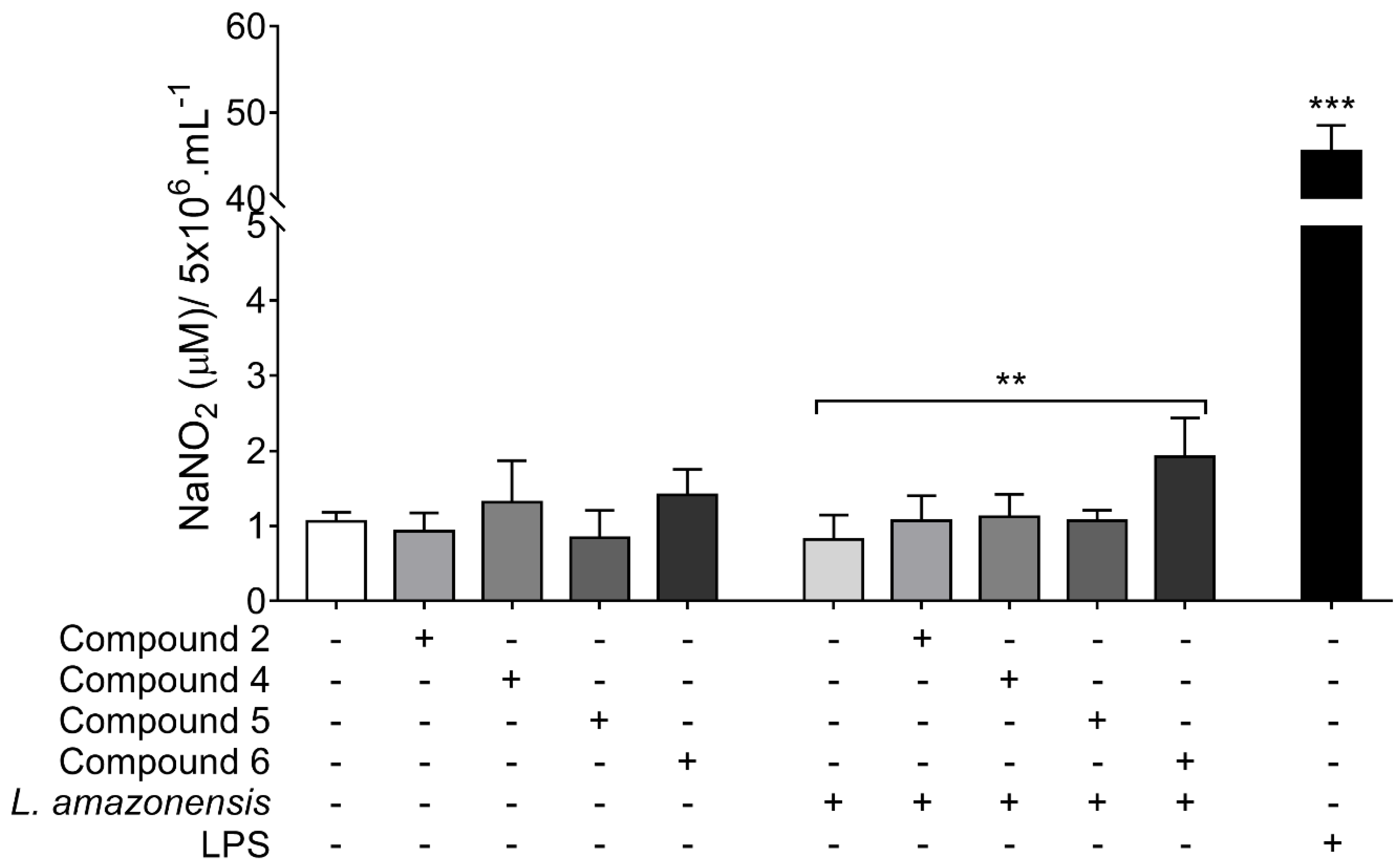
| Compounds | IC50 (µM) | CC50 (µM) | SI | |
|---|---|---|---|---|
| Promastigote | Intracellular Amastigote | |||
| 1 | 53.70 ± 8.467 | – | 221.20 ± 4.824 | – |
| 2 | 8.85 ± 3.436 | 37.92 ± 3.350 | 248.46 ± 2.519 | 6.55 |
| 3 | 50.93 ± 4.571 | – | 307.73 ± 4.071 | – |
| 4 | 15.68 ± 5.418 | 149.8 ± 6.367 | 144.80 ± 4.100 | 0.96 |
| 5 | 8.81 ± 3.933 | 32.31 ± 2.256 | 58.01 ± 2.647 | 1.79 |
| 6 | 14.64 ± 4.392 | 17.78 ± 3.257 | 547.88 ± 3.256 | 30.81 |
| 7 | 62.98 ± 5.878 | – | 412.00 ± 4.917 | – |
| 8 | >300 | – | >600 | – |
| 9 | >300 | – | >600 | – |
| 10 | >300 | – | >600 | – |
| Miltefosine | 8.56 ± 0.695 | 11.615 ± 1.790 | 152.61 ± 3.855 | 13.13 |
| Property/Model Name | Compounds | ||||
|---|---|---|---|---|---|
| 2 | 4 | 5 | 6 | Miltefosine | |
| Physicochemical | |||||
| Molecular Weight | 480.484 | 333.347 | 447.52 | 369.429 | 407.576 |
| # Rotatable bonds | 10 | 7 | 8 | 7 | 20 |
| # H-bond acceptors | 8 | 5 | 6 | 4 | 4 |
| # H-bond donors | 0 | 0 | 1 | 1 | 0 |
| Surface Area | 205.260 | 144.553 | 185.782 | 162.657 | 168.579 |
| TPSA (Å2) | 114.02 | 66.24 | 106.85 | 64.33 | 68.40 |
| Lipophilicity (Log Po/w) | 2.87 | 2.63 | 3.24 | 3.70 | 3.83 |
| Drug-likeness | |||||
| Lipinski | Yes; 0 violation | Yes; 0 violation | Yes; 0 violation | Yes; 0 violation | Yes; 0 violation |
| Ghose | No; 1 violation: MW > 480 | Yes | Yes | Yes | No; 2 violations: WLOGP > 5.6, #atoms > 70 |
| Veber | Yes | Yes | Yes | Yes | No; 1 violation: Rotors > 10 |
| Egan | Yes | Yes | Yes | Yes | No; 1 violation: WLOGP > 5.88 |
| Muegge | Yes | Yes | Yes | Yes | No; 2 violations: XLOGP3 > 5, Rotors > 15 |
| Medicinal chemistry | |||||
| PAINS | 0 alert | 0 alert | 0 alert | 0 alert | 0 alert |
| Brenk | 1 alert: aldehyde | 2 alerts: aldehyde, triple bond | 1 alert: imine | 1 alert: imine | 2 alerts: phosphor, quaternary nitrogen |
| Lead-likeness | No; 2 violations: MW > 350, Rotors > 7 | Yes | No; 3 violations: MW > 350, Rotors > 7, XLOGP3 > 3.5 | No; 2 violations: MW > 350, XLOGP3 > 3.5 | No; 3 violations: MW > 350, Rotors > 7, XLOGP3 > 3.5 |
| Synthetic accessibility | 3.44 | 3.00 | 3.52 | 3.25 | 4.67 |
| Property | Model Name | Compounds | ||||
|---|---|---|---|---|---|---|
| 2 | 4 | 5 | 6 | Miltefosine | ||
| Absorption | Water solubility (log mol/L) | −4.143 | −4.327 | −5.487 | −5.382 | −6.149 |
| Caco-2 permeability (log Papp in 10−6 cm/s) | 0.538 | 1.178 | 0.776 | 0.516 | 1.049 | |
| Intestinal absorption – human (% Absorbed) | 95.298 | 100 | 93.529 | 92.221 | 92.021 | |
| Skin Permeability (log Kp) | −2.735 | −2.641 | −2.739 | −2.732 | −2.721 | |
| P-glycoprotein substrate | No | No | Yes | Yes | No | |
| P-glycoprotein I inhibitor | Yes | Yes | Yes | Yes | Yes | |
| P-glycoprotein II inhibitor | Yes | Yes | Yes | Yes | Yes | |
| Distribution | Human ssVD (log L/kg) | 0.068 | −0.284 | −0.241 | −0.236 | 0.355 |
| BBB permeability (log BB) | −1.675 | 0.039 | −0.843 | 0.393 | −0.176 | |
| CNS permeability (log PS) | −3.531 | −2.579 | −2.455 | −1.997 | −3.191 | |
| Metabolism | CYP2D6 substrate | No | No | No | No | No |
| CYP3A4 substrate | Yes | Yes | Yes | Yes | Yes | |
| CYP1A2 inhibitor | No | Yes | No | Yes | No | |
| CYP2C19 inhibitor | No | Yes | Yes | Yes | No | |
| CYP2C9 inhibitor | Yes | Yes | Yes | Yes | No | |
| CYP2D6 inhibitor | No | No | No | No | No | |
| CYP3A4 inhibitor | Yes | No | Yes | Yes | No | |
| Excretion | Total Clearance (log mL/min/kg) | 0.386 | 0.35 | 0.671 | 0.199 | 1.112 |
| Renal OCT2 substrate | No | Yes | No | No | No | |
| Toxicity | AMES toxicity | No | No | Yes | Yes | No |
| Human max. tolerated dose (log mg/kg/day) | 0.796 | 0.692 | 0.844 | 0.898 | 0.211 | |
| hERG I inhibitor | No | No | No | No | No | |
| hERG II inhibitor | Yes | Yes | Yes | Yes | Yes | |
| Oral Rat Acute Toxicity LD50 (mol/kg) | 3.024 | 1.949 | 2.747 | 2.599 | 2.655 | |
| Oral Rat Chronic Toxicity LOAEL (log mg/kg bw/day) | 0.653 | 1.39 | 0.462 | 0.99 | 0.233 | |
| Hepatotoxicity | Yes | Yes | Yes | Yes | Yes | |
| Skin Sensitization | No | No | No | No | Yes | |
| T pyriformis toxicity (log µg/L) | 0.285 | 0.474 | 0.294 | 0.327 | 0.311 | |
| Minnow toxicity (log mM) | −1.708 | −1.322 | −2.1 | −3.393 | −1.839 | |
© 2020 by the authors. Licensee MDPI, Basel, Switzerland. This article is an open access article distributed under the terms and conditions of the Creative Commons Attribution (CC BY) license (http://creativecommons.org/licenses/by/4.0/).
Share and Cite
Almeida-Souza, F.; Silva, V.D.d.; Silva, G.X.; Taniwaki, N.N.; Hardoim, D.d.J.; Buarque, C.D.; Abreu-Silva, A.L.; Calabrese, K.d.S. 1,4-Disubstituted-1,2,3-Triazole Compounds Induce Ultrastructural Alterations in Leishmania amazonensis Promastigote: An in Vitro Antileishmanial and in Silico Pharmacokinetic Study. Int. J. Mol. Sci. 2020, 21, 6839. https://doi.org/10.3390/ijms21186839
Almeida-Souza F, Silva VDd, Silva GX, Taniwaki NN, Hardoim DdJ, Buarque CD, Abreu-Silva AL, Calabrese KdS. 1,4-Disubstituted-1,2,3-Triazole Compounds Induce Ultrastructural Alterations in Leishmania amazonensis Promastigote: An in Vitro Antileishmanial and in Silico Pharmacokinetic Study. International Journal of Molecular Sciences. 2020; 21(18):6839. https://doi.org/10.3390/ijms21186839
Chicago/Turabian StyleAlmeida-Souza, Fernando, Verônica Diniz da Silva, Gabriel Xavier Silva, Noemi Nosomi Taniwaki, Daiana de Jesus Hardoim, Camilla Djenne Buarque, Ana Lucia Abreu-Silva, and Kátia da Silva Calabrese. 2020. "1,4-Disubstituted-1,2,3-Triazole Compounds Induce Ultrastructural Alterations in Leishmania amazonensis Promastigote: An in Vitro Antileishmanial and in Silico Pharmacokinetic Study" International Journal of Molecular Sciences 21, no. 18: 6839. https://doi.org/10.3390/ijms21186839
APA StyleAlmeida-Souza, F., Silva, V. D. d., Silva, G. X., Taniwaki, N. N., Hardoim, D. d. J., Buarque, C. D., Abreu-Silva, A. L., & Calabrese, K. d. S. (2020). 1,4-Disubstituted-1,2,3-Triazole Compounds Induce Ultrastructural Alterations in Leishmania amazonensis Promastigote: An in Vitro Antileishmanial and in Silico Pharmacokinetic Study. International Journal of Molecular Sciences, 21(18), 6839. https://doi.org/10.3390/ijms21186839







